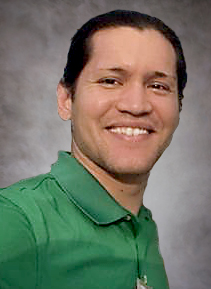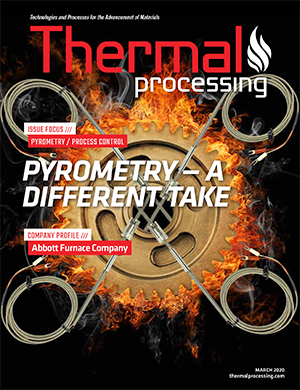
Editor’s note: Beginning with the March 2020 issue of Thermal Processing, there will be multiple contributors to the Quality Counts column. Conrad Kacsik’s Jason Schulze will continue to write occasional columns. This month, meet Tony Tenaglier, heat treat process engineer at Hitchiner Manufacturing.
Before I get into the specifics of my views on and experience in process engineering, I’ll start with a quick look at my life from a black and white perspective (the classic resume lens):
- Heat treat engineer with four years’ experience (ferrous and nonferrous alloys; vacuum, salt, carburizing, nitriding, HIP processes).
- Experience with Nadcap and AS9100 audits.
- Experience with AMS2750.
- Process engineering.
- Manager experience.
And my life with a little more color (a life size optical microscope lens):
- Professional network of friends and work colleagues.
- Adherence to the statement “say what you do, do what you say”; credibility, and a man of his word in all aspects of life.
- Engineer inspired by marathon running work ethic (marathons in 12 of the 50 states).
- kNowhere kidS band’s drummer finding rhythms in the process of heat treat and manufacturing, and coordinating the overall song and dance of the process.
Process engineering isn’t just about the consideration of technical details. It also requires engineering the relationships of people in a given process. Success, taught in school, is not the result of good luck, but rather good “skill.” And it is the emphasis of good skill that has always resonated with me in my career as an engineer. It was my adviser who once taught me this after having gone through the courses of thermodynamics and kinetics, which I enjoyed most in my academic studies. One day in his office after discussing senior design possibilities, he associated thermodynamics — the knowledge of thermal (heat treat)/pressure (hot isostatic pressure) considerations in which a system of atoms wants to be energetically favorable — to the study of psychology. The premise was that humans, too, seek states of energy that are desirable in their lives and it is of importance to also acquire this knowledge.
Sure, it is important to have skills such as knowledge of the Gibbs free energy considerations in binary phase diagrams to establish suitable heat treat temperatures of solution or annealing. But it is of equal importance to consider, in a working environment, the relationships with people — how binary relationships of people also govern the way the process moves and where it needs to get to in an organization.
This was the foundation to my engineering career. It was the first stepping stone that taught me to combine both theoretical aspects of material science with that of human relations. It was then that I went on to work at a steel manufacturing company in Ohio to help with the startup of an electric arc furnace. Practicing the skills of human relations, I took on the role of manager and created a team to develop a brand-new department and the technical requirements needed.
However, at the time, I still needed to refine my skills of developing and maintaining human relations, as I got upset when a new incentive plan was initiated for the company — the idea that the “carrot” was placed out in front of the teams to run after and get. Now, I agree with some people being motivated by extrinsic rewards, but others are often motivated by intrinsic rewards to the same degree, meaning that the desire for doing something for the sake of doing it transcends that of monetary value. (I’m not suggesting that people work for free!) Rather, the hard work put into the team seemed to crumble fast when the extrinsic reward did not match the reality of the production capability. After losing my temper and being frustrated, I was let go. It was a lesson I needed to learn in life.
But for every experience, there is a lesson. It reminded me of the need to continually develop who I was as a person and how I interacted with others. From there, I was left unemployed and finished a book called The Impression of a Good Life: Philosophical Engineering. It was a job description I needed in order to get my life back on track and working toward the right things.
Shortly thereafter, a small family-owned heat-treat company in Cleveland, Ohio, found my resume and interviewed me. I will never forget my first interview with Katie, one of the owners at General Metal Heat Treat, and how we communicated so effortlessly. The idea that in a small company of about 25 employees, we both emphasized how important it was going to be for me to manage not only the development of heat-treat processes, but also that of the relations with the employees who worked there. During my time there, I found myself engaged in Nadcap audits, restructuring the company’s interpretations of AS9100 principles, and learning what it meant to really be part of a team.
However, it isn’t just teamwork that is of value, and a few years later I found myself wanting to go home to New Hampshire, where I grew up and where my immediate family still lives. This is when I landed at Hitchiner Manufacturing and became its heat treat process engineer.
I feel honored to write in a technical journal sharing not only the positive things I’ve learned along the way, but how I’ve also learned from the negative. I’ve learned that the aspects of heat treat include and extend beyond binary phase diagrams, TTT curves, and AMS specifications, and that they really embrace more of the philosophy of AS9100 requirements for a workplace culture.
I’ve learned that work-life balance is important, but I also realized both are really one and the same. My drumming in the band can help my understanding of the rhythm for a process, or that specification review can help in my ability to develop proper marathon running training programs in making sure I cover all aspects that are required.
As I consider topics for future column topics, a few come to mind:
- The art of heat treat.
- Knowing the “why” in heat treat.
I’m sure other topics will spontaneously occur, and I’m looking forward to sharing ideas with Thermal Processing readers.


























